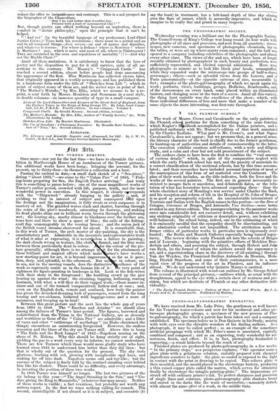THE FLEMISH SCHOOL.*
The work of Messrs. Crowe and Cavalcaselle on the early painters of the Flemish sell.. performs for them something of the same function
which Kugler's dbook accomplished for the Italian painters, and is published unifo y with Mr. Murray's edition of that work annotated ' by Sir Charles Eastlake. What part is Mr. Crowe's, and what Signor Cavalcaselle's, does not appear; but we presume that, in a general sense, the literary character of the book is chiefly due to the former gentleman, its hunting-up of authorities and details of connoisseurship to the latter. The execution exhibits cautious self-reliance, with a wide and diligent study, and a calm and clear but not cold presentment of the subject.
The authors claim to have been the first to combine the "vast amount of curious details" which, in spite of the comparative neglect with which the early Flemish school has met, and the paucity of materials for a correct classification of the sectional schools, has by this time ae,cumu- lated ; and their researches have included personal inspection of most of the masterpieces of this form of art scattered over the Continent. The plan of their work includes, as the title indicates, both the lives and the works of the several painters. The first are in general necessarily re- stricted to meagre facts or anecdotes, and debateable dates, or the refu- tation of what has heretofore been advanced regarding these : thus the whole cherished story of Memling's war service under Charles the Rash, and his reception and reform of life in the Hospital of St. John of Bruges, is as good as peremptorily rejected. An uncomfortable intermixture of Teutonic and Italian with the English names in this portion—as the Dom of Cologne, Giovanni of Bruges, and Antonello Van Skilien—were better avoided in any future edition. The passages relating to the painters' works enter into considerable but not excessive detail, and, without exhibiting any striking originality of criticism or descriptive power, are honest and well-balanced; the school being, indeed, one in the estimating of which it is eminently needful that the sympathy should be discriminating, and the admiration cordial but not unqualified. The attribution made by former critics of particular works to particular men is vigorously over- hauled ; the Berlin and Munich Galleries especially being turned topsy- turvy. The review divides early Flemish art into the schools of Bruges and of Louvain; beginning with the primitive efforts of Melchior Broe- derlain and others, and pursuing the subject, through Hubert and John van Eyck, (to the former of whom the authors award the supremacy in art, and a superintending share in the discovery of oil-painting,) through Van der Weyden, the Flemicized Sicilian Antonello da Messina, Mem- ling, Dierick Stuerbout, and some of their contemporaries, to a more rapid view of the progress of the art in Flanders, and its influence abroad. We do not understand why Quintin Matsys is omitted.
The volume is illustrated with wood-cut outlines by Mr. George Scharf from several of the principal pictures,—outlines which, as usual with the draughtsman, appeal to the eye with a certain show of neatness and pre- cision, but which are destitnte of Flemish or any other distinctive indi- viduality.
* The Early Flemish Painters : Notices of their Lives and Works. By A. Crowe and G. B. Cavaleaselle. Published by Murray.
































 Previous page
Previous page